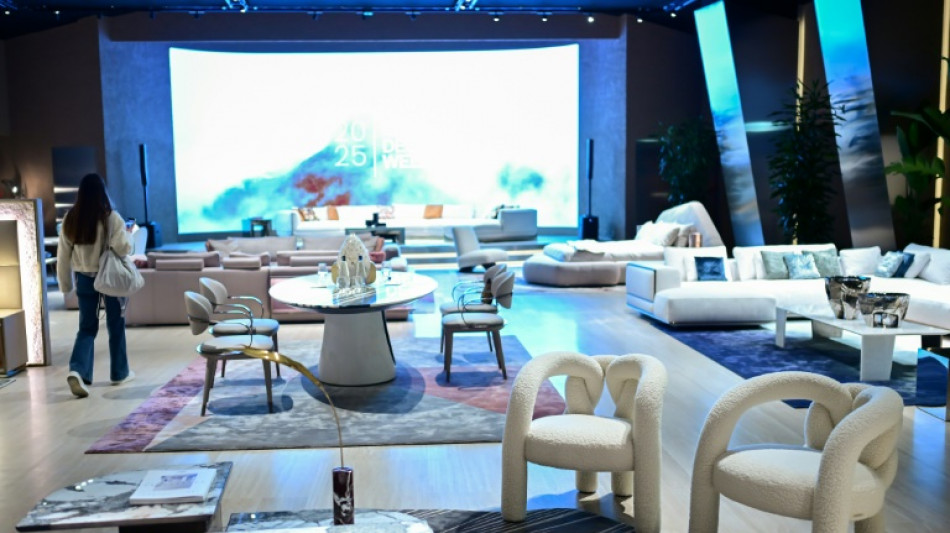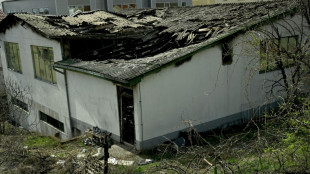
Trump tariffs leave Italy's luxury furniture makers sitting uncomfortably

Even the most sumptuous cushions cannot ease the pain that Italian luxury furniture makers -- gathered at their annual fair -- can already feel from US President Donald Trump's tariffs.
Some companies at the Milan Furniture Fair, which opened Tuesday, compare the sudden levies to a rampaging wrecking crew. But many are also determined to keep offering their prestige output in the hope that buyers in the key US market will stick with them.
The United States is the Italian furniture industry's second-biggest market after France, accounting for 2.2 billion euros ($2.4 billion) of its 19.4 billion euros of exports in 2024, according to industry figures.
The "geopolitical" factors, such as the new tariffs, "will certainly have long-term repercussions," the fair's president Maria Porro told AFP.
About 10 percent of all Italy's exports go to the United States, and Prime Minister Georgia Meloni will go to Washington on April 17 in a bid to ease the impact of the 20-percent tariffs imposed on European Union products.
Some furniture firms say it is too early to know how much damage can be expected from the tariffs that have shaken global markets.
"We made it through Covid, we had the war in Ukraine and lost Russian clients, but we survived," said Nicola Fagetti, finance director of the Parma company La Contessina, which prides itself on producing a modern version of Italian renaissance styles.
"We are now facing tariffs, but we always find a solution," he said stoically. US sales account for 35 percent of his company's made-to-order exports.
Emmanuel Antonello, marketing director for Villari, a luxury brand whose tables can cost more than $20,000, is also refusing to panic.
"The United States accounts for 20 percent of our exports, but we can still count on our sales in the Middle East, our primary market with a 60 percent share," he said.
And he's banking on customer loyalty across the Atlantic: "Americans are fascinated by Italian design -- there's a 'Wow!' effect when they see our products; for them, they're gems."
- Absent Americans -
But there are few Americans roaming the fair this year, while they were the sixth-largest foreign contingent in 2024.
"I will lose a lot of my clients. I think the tariffs are going to be enormously awful for trade," said interior designer Allison Muir, a 48-year-old from San Francisco and a fan of the late Italian designer Gio Ponti.
"Italian design can really relax the mind and create a place to really reflect. And I think that's what a lot of my clients are looking for in the frenetic Silicon Valley," she said.
Upset with Trump's policies, she is considering leaving the United States and settling with her family in Seville, Spain.
A decline in exports to France (-3.3 percent) and Germany (-6 percent) already helped drag down the Italian furniture industry's revenues last year by more than two percent to 27.5 billion euros.
"Even though some emerging markets are growing, such as the United Arab Emirates and Saudi Arabia, they are still unable to make up for traditional markets," said Porro, the fair's president.
Turning to trends at the 63rd edition of the Salone del Mobile, she said clients are increasingly interested in sustainability and a return to nature.
"In a period of instability like the one we are experiencing now, people prefer natural, bright and warm shades," she said, adding that the border between design and art is increasingly blurred.
The giant show, open until Sunday, has 2,103 exhibitors, with more than a third from outside Italy. Last year, it attracted 370,824 visitors from around the world, a 20 percent increase on 2023.
L.Lefevre--PS

 London
London

 Manchester
Manchester
 Glasgow
Glasgow
 Dublin
Dublin
 Belfast
Belfast
 Washington
Washington
 Denver
Denver
 Atlanta
Atlanta
 Dallas
Dallas
 Houston Texas
Houston Texas
 New Orleans
New Orleans
 El Paso
El Paso
 Phoenix
Phoenix
 Los Angeles
Los Angeles



